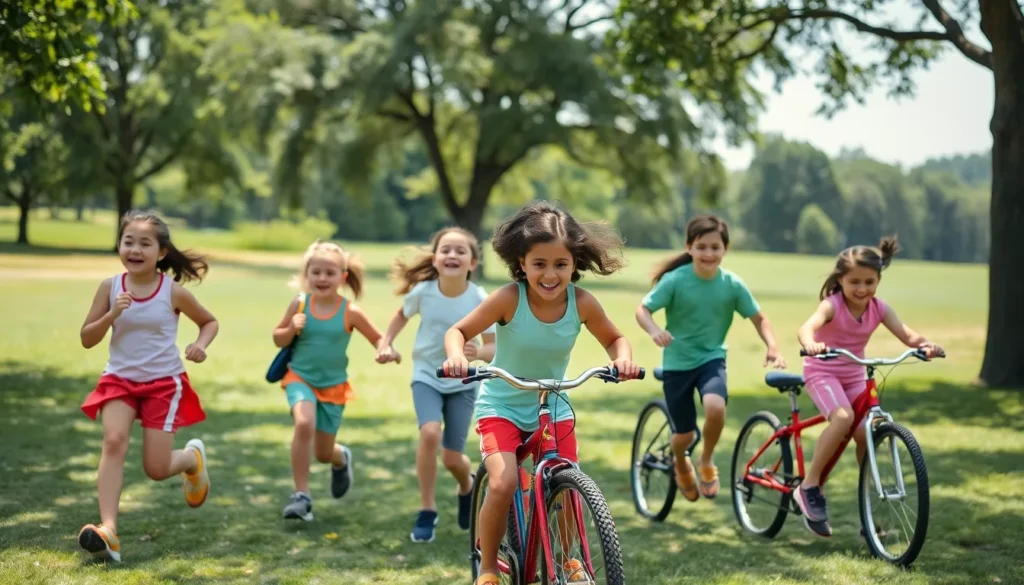Table of Contents
ToggleIn a world where kids are glued to screens more than ever, getting them moving can feel like a Herculean task. But fear not! Kid-friendly exercises are here to save the day, turning fitness into a fun adventure rather than a chore. Imagine your little ones laughing and playing while sneaking in some healthy movement. Sounds like a win-win, right?
Understanding Kid-Friendly Exercises
Kid-friendly exercises promote an active lifestyle among children, offering enjoyable ways to stay fit. These activities engage kids physically and mentally, encouraging them to move more.
Importance for Physical Development
Physical development thrives when children participate in active exercises. Growing bodies benefit from strength-building activities, helping to develop muscles and bones. Coordination improves as kids engage in fun games like tag or obstacle courses. Regular movement supports healthy cardiovascular systems, which is vital for overall wellness. Engaging methods can also battle obesity, as active habits reduce the risk of weight-related health issues. Research indicates that children who exercise consistently often achieve better physical milestones and learn essential motor skills.
Benefits for Mental Health
Mental health significantly improves with regular physical activity. Exercise releases endorphins, natural mood lifters that can alleviate feelings of anxiety and depression. Kids experience increased self-esteem through exercise, especially when achieving personal fitness goals. Social interactions during group activities help develop friendships and support, fostering a sense of belonging. Creativity also flourishes during playful movement, as children express themselves through dance or sports. Studies show that active kids tend to concentrate better in school, enhancing their overall academic performance.
Types of Kid-Friendly Exercises
Kid-friendly exercises encompass a variety of engaging activities that promote physical fitness for children. These exercises can take place indoors or outdoors and often encourage play and social interaction.
Outdoor Activities
Outdoor activities provide fresh air and an opportunity for kids to explore their environment. Popular options include biking, jogging, playing tag, and flying kites. Nature walks allow children to observe wildlife and appreciate nature while staying active. Organizing scavenger hunts promotes teamwork and problem-solving skills. Group games, like soccer or capture the flag, build friendships while enhancing physical fitness.
Indoor Games
Indoor games offer a fantastic way to keep children active even when weather conditions aren’t ideal. Options include jump rope, dancing to music, or playing obstacle courses created with household items. Board games that incorporate movement, like Twister, encourage physical engagement and laughter. Interactive video games that require movement combine fun and fitness for children. Indoor bowling or mini-golf can also be set up using simple equipment.
Sports and Team Activities
Sports and team activities present structured environments for children to engage in fitness. Popular sports include soccer, basketball, and baseball, which enhance coordination and teamwork. Joining local leagues helps kids develop skills while forming friendships. Swimming offers both competitive and recreational opportunities for varied skill levels. Martial arts programs build confidence and discipline while improving overall fitness.
Engaging Kids in Exercise
Engaging kids in exercise involves blending fun with physical activity. Encouraging participation through enjoyable methods keeps children motivated.
Fun and Interactive Methods
Incorporating games into exercise makes it more appealing. Tag, capture the flag, or relay races draw kids into movement. Dance parties transform a regular living room into a vibrant exercise space. Team sports foster collaboration, enhancing social skills while promoting fitness. Obstacle courses serve as both a challenge and a workout, sparking creativity and problem-solving. Utilizing technology, such as fitness apps designed for kids, can also increase interest. These approaches create an energetic atmosphere that drives engagement.
Incorporating Exercise into Daily Routines
Exercise can seamlessly fit into daily activities. Walking or biking to school promotes fitness as part of the morning routine. Family game nights using active video games encourage friendly competition and physical movement. Scheduled outdoor playtime after school ensures children enjoy fresh air and activity. Homework breaks featuring short bursts of jumping jacks or stretching keep energy levels up. Allowing kids to participate in household chores provides a practical way to integrate movement. These simple strategies help establish a lifestyle centered around regular physical activity.
Safety Considerations
Safety remains a primary concern when engaging children in exercises. Appropriate precautions ensure that kids enjoy physical activities while minimizing risks.
Suitable Age Groups
Different exercises cater to specific age groups. Preschool-age children thrive in activities that develop basic motor skills, such as crawling or jumping. School-age children can engage in more complex games that require coordination, like soccer or basketball. Adolescents benefit from exercises that enhance strength and endurance, including swimming or team sports. Understanding suitability helps parents choose the right activities, fostering both safety and enjoyment.
Proper Supervision and Guidance
Supervision plays a crucial role in ensuring safety during kid-friendly exercises. Parents and coaches should monitor children closely, providing immediate assistance when necessary. Guidelines for instruction help kids understand techniques and rules, reducing the chance of accidents. Group activities benefit from adult oversight, promoting teamwork while keeping everyone safe. Engaging with children during exercises adds an element of fun and encourages them to stay active responsibly.
Fostering an active lifestyle in children is essential for their overall development. By incorporating fun and engaging exercises into their routines, parents can help kids enjoy movement while reaping the numerous physical and mental benefits.
Whether it’s outdoor adventures or indoor games, the key lies in making fitness a joyful experience. With the right approach and supervision, children can build healthy habits that last a lifetime. Encouraging playful activities not only promotes physical health but also strengthens social bonds and enhances creativity.
Ultimately, prioritizing kid-friendly exercises can pave the way for a healthier and happier generation.




